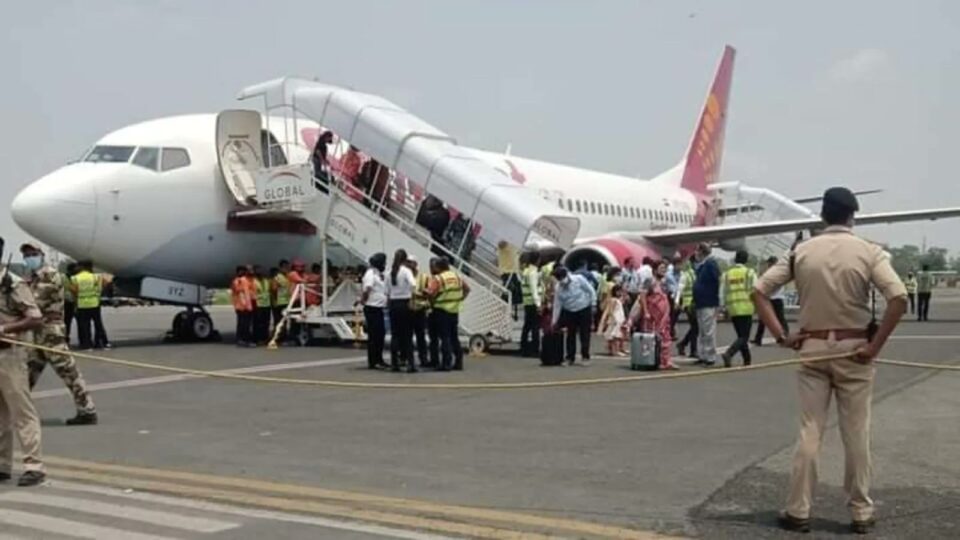Aviation
Spice Jet suffers 7 emergency landings in 17 days, trouble brewing for airline.

On Tuesday, a Spice Jet flight from Delhi to Dubai suffered a fuel indication malfunction in the air and had to be diverted to Karachi. At a height of 23,000 feet, the windshield of another Spice Jet started to break, necessitating an urgent landing in Mumbai. The budget airline suffered two defeats in a single day, bringing the total number of technical fault issues involving Spice Jet aircraft to seven during the previous 17 days. Although neither of the two parties in this case has made a statement, officials of the Directorate General of Civil Aviation (DGCA) claim that the aviation regulator of India is looking into each of the seven events and may take actions against the airline if it determines that it is at fault.
Regarding the seven incidents, six were domestic flights and one was an international flight. On June 5 in the early morning, a Spice Jet Boeing 737 Max carrying about 150 passengers on a trip from Delhi to Dubai was reported to have an international flight incident when it made an emergency landing in Karachi, Pakistan. While in the air, the plane began to exhibit an odd fuel quantity reduction from its left tank, which caused it to be redirected to Karachi.
When an inspection was done at the Karachi airport, no visual leak was observed from the left tank, they added. Spice Jet deputed another aircraft from India in the evening and by 10 PM in the night, all passengers left for Dubai again, spending 12 hours in Pakistan.
In the second incident, the Q400 plane’s windshield cracked at a height of 23,000 feet, forcing the pilots to make a quick landing at the Mumbai airport, according to DGCA officials. It was not immediately known how many people were travelling on the 78-seat Q400 aircraft on the Kandla-Mumbai journey. According to them, the aircraft had no problems with cabin pressurization. “Spice Jet Q400 aircraft was flying SG 3324 on July 5th, 2022. (Kandla-Mumbai). At FL230 (23,000 feet above sea level), the P2 side windshield outer pane cracked. It was noted that pressurization was typical. The plane touched down safely in Mumbai “In a statement, Spice Jet said.
On June 19, the carrier’s flight bound for Delhi with 185 passengers experienced an engine fire shortly after departure from Patna airport and necessitating an emergency landing. Because of the bird strike, the engine broke down. The plane’s pilot, Monica Khanna, is given credit for a successful landing after one of the most significant occurrences in recent days.
In another incident on June 19, a flight for Jabalpur had to return to Delhi due to cabin pressurization issues. Fuselage door warnings lit up on two separate planes while taking off on June 24 and June 25, forcing them to abandon their journeys and return.
On July 2, a flight to Jabalpur made a turn back to Delhi when the crew noticed smoke in the cabin at a height of about 5,000 feet.
One more on 5th of july, Due to a malfunctioning weather radar, a Spice Jet cargo flight headed for China made a Tuesday return to Kolkata. The Spice Jet cargo Boeing 737 was supposed to fly from Kolkata to Chongqing, however the spokesperson said that after takeoff it was discovered that the weather radar was inoperable. The pilot-in-command made the decision to return to Kolkata and successfully touched down there.

Aviation
Boeing, Antonov to Collaborate on Defense Projects

– MOU represents Boeing’s commitment to work with Ukrainian industry
– Includes exploring opportunities for collaborating on in-country support of Unmanned Aerial Systems
A Memorandum of Understanding was signed today by Boeing and Antonov Company to investigate potential collaboration on defense-related projects.
“We’re happy to keep collaborating with the Antonov Company to help Ukraine’s economic development and expansion,” stated Ted Colbert, CEO and president of Boeing Defence, Space, & Security.
Airbus and the Antonov An-225: The Best Partnership:Click here
“This agreement demonstrates our ongoing efforts to find more opportunities to work with Ukrainian industry, which was underscored by our signing of the Ukrainian Defence Industry Compact earlier this year.”
The areas of potential collaboration identified in the agreement consist of training, logistical support and overhaul services for tactical Unmanned Aerial Systems utilized by the Ukrainian Armed Forces, which includes the ScanEagle. In addition, the companies will also explore opportunities for Antonov to provide engineering support to Boeing.
The six largest cargo aircraft ever built in the aviation industry:Click here
“A strong, innovative, and efficient defense industry is key to sustainable economic development and national security, and we are extremely excited to collaborate with Boeing,” said Ievhen Gavrylov, CEO of Antonov Company.
This agreement brings a whole new level of opportunity to implement the latest and most effective solutions – in addition to the possibility of future projects with Boeing in the aerospace and defense industry.”
-

 Travel1 week ago
Travel1 week agoAir India to Expand US Operations with Three New Routes After a Decade
-

 Travel2 weeks ago
Travel2 weeks agoWhy We Should Avoid These Stamps in a Passport
-

 Airlines1 month ago
Airlines1 month agoInvestigations Reveal Fake Chinese Titanium in Boeing and Airbus Jets
-

 Tech4 weeks ago
Tech4 weeks agoChina’s CATL Plans 1,800-Mile Electric Plane Launch by 2027
-

 Airport3 days ago
Airport3 days agoTop 10 Largest Airports in the World by Size
-

 Aerospace4 weeks ago
Aerospace4 weeks agoChina’s Fighter Jets Turn Wings into Autonomous Drones
-

 Airlines4 days ago
Airlines4 days agoAir India Rolls Out A350s for Delhi-New York JFK and Newark Routes
-

 Defence3 weeks ago
Defence3 weeks agoBoeing Enhances Chinook with New Engines and Block II Upgrades at $96 Million







